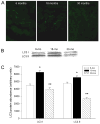Age-related changes of cell death pathways in rat extraocular muscle
- PMID: 19341788
- PMCID: PMC2720059
- DOI: 10.1016/j.exger.2009.03.006
Age-related changes of cell death pathways in rat extraocular muscle
Abstract
Changes in the structure and function of aging non-locomotor muscles remains understudied, despite their importance for daily living. Extraocular muscles (EOMs) have a high incidence of age-related mitochondrial defects possibly because of the metabolic stress resulting from their fast and constant activity. Apoptosis and autophagy (type I and II cell death, respectively) are linked to defects in mitochondrial function and contribute to sarcopenia in hind limb muscles. Therefore, we hypothesized that apoptosis and autophagy are altered with age in the EOMs. Muscles from 6-, 18-, and 30-month-old male Fisher 344-Brown Norway rats were used to investigate type I cell death, caspase-3, -8, -9, and -12 activity, and type II cell death. Apoptosis, as measured by TUNEL positive nuclei, and mono- and oligo-nucleosomal content, did not change with age. Similarly, caspase-3, -8, -9, and -12 activity was not affected by aging. By contrast, autophagy, as estimated by gene expression of Atg5 and Atg7, and protein abundance of LC3 was lower in EOMs of aged rats. Based on these data, we suggest that the decrease in autophagy with age leads to the accumulation of damaged organelles, particularly mitochondria, which results in the decrease in function observed in EOM with age.
Figures




Similar articles
-
Skeletal muscle autophagy and apoptosis during aging: effects of calorie restriction and life-long exercise.Exp Gerontol. 2010 Feb;45(2):138-48. doi: 10.1016/j.exger.2009.11.002. Epub 2009 Nov 10. Exp Gerontol. 2010. PMID: 19903516 Free PMC article.
-
Sarcopenia-related apoptosis is regulated differently in fast- and slow-twitch muscles of the aging F344/N x BN rat model.Mech Ageing Dev. 2006 Aug;127(8):670-9. doi: 10.1016/j.mad.2006.03.005. Epub 2006 May 4. Mech Ageing Dev. 2006. PMID: 16678239
-
Regrowth after skeletal muscle atrophy is impaired in aged rats, despite similar responses in signaling pathways.Exp Gerontol. 2015 Apr;64:17-32. doi: 10.1016/j.exger.2015.02.007. Epub 2015 Feb 12. Exp Gerontol. 2015. PMID: 25681639 Free PMC article.
-
Autophagy as a Potential Target for Sarcopenia.J Cell Physiol. 2016 Jul;231(7):1450-9. doi: 10.1002/jcp.25260. Epub 2015 Dec 10. J Cell Physiol. 2016. PMID: 26580995 Review.
-
Mitochondrial dysfunction and sarcopenia of aging: from signaling pathways to clinical trials.Int J Biochem Cell Biol. 2013 Oct;45(10):2288-301. doi: 10.1016/j.biocel.2013.06.024. Epub 2013 Jul 8. Int J Biochem Cell Biol. 2013. PMID: 23845738 Free PMC article. Review.
Cited by
-
Evolving concepts on the age-related changes in "muscle quality".J Cachexia Sarcopenia Muscle. 2012 Jun;3(2):95-109. doi: 10.1007/s13539-011-0054-2. Epub 2012 Feb 3. J Cachexia Sarcopenia Muscle. 2012. PMID: 22476917 Free PMC article.
-
Nrf2 deficiency promotes the increasing trend of autophagy during aging in skeletal muscle: a potential mechanism for the development of sarcopenia.Aging (Albany NY). 2020 Apr 3;12(7):5977-5991. doi: 10.18632/aging.102990. Epub 2020 Apr 3. Aging (Albany NY). 2020. PMID: 32244226 Free PMC article.
-
The Effects of Calcium-β-Hydroxy-β-Methylbutyrate on Aging-Associated Apoptotic Signaling and Muscle Mass and Function in Unloaded but Nonatrophied Extensor Digitorum Longus Muscles of Aged Rats.Oxid Med Cell Longev. 2020 Jul 23;2020:3938672. doi: 10.1155/2020/3938672. eCollection 2020. Oxid Med Cell Longev. 2020. PMID: 32774671 Free PMC article.
-
The Role of Mitophagy in Skeletal Muscle Damage and Regeneration.Cells. 2023 Feb 24;12(5):716. doi: 10.3390/cells12050716. Cells. 2023. PMID: 36899852 Free PMC article. Review.
-
Age-related changes in the function of autophagy in rat kidneys.Age (Dordr). 2012 Apr;34(2):329-39. doi: 10.1007/s11357-011-9237-1. Epub 2011 Apr 1. Age (Dordr). 2012. PMID: 21455601 Free PMC article.
References
-
- Alway SE, Degens H, Krishnamurthy G, Chaudrhrai A. Denervation stimulates apoptosis but not Id2 expression in hindlimb muscles of aged rats. J Gerontol A Biol Sci Med Sci. 2003;58:687–697. - PubMed
-
- Alway SE, Degens H, Krishnamurthy G, Smith CA. Potential role for Id myogenic repressors in apoptosis and attenuation of hypertrophy in muscles of aged rats. Am J Physiol Cell Physiol. 2002;283:C66–C76. - PubMed
-
- Andrade FH, Hatala DA, McMullen CA. Carbonic anhydrase isoform expression and functional role in rodent extraocular muscle. Pflugers Arch. 2004;448:547–51. - PubMed
-
- Baker DJ, Hepple RT. Elevated caspase and AIF gene expression correlate with progression of sarcopenia during aging in male F344BN rats. Exp Gerontol. 2006;41:1149–1156. - PubMed
Publication types
MeSH terms
Substances
Grants and funding
LinkOut - more resources
Full Text Sources
Medical
Molecular Biology Databases
Research Materials

